The Only Honest Lake in Texas
It looks like a winner has emerged in the struggle for Caddo Lake
A table full of good ol’ boys and good ol’ girls are having a hoot over lunch at Dawn’s, under the bridge where State Highway 43 crosses the western edge of Caddo Lake. One in the crowd claims he’s been seeing blue UN flags popping up all over the lake, hearing folks speaking Esperanto and Ebonics, and observing some lake people engaging in secret handshakes—all sure signs the United Nations has taken over Caddo Lake.
“That’ll give the general heart palpitations,” one big bubba cackles.
The “general” is retired General Vernon Lewis, the lake resident who co-sponsored a resolution along with Ed Smith, the mayor of nearby Marshall, in the 2004 Texas Republican Party platform condemning the Caddo Lake Institute and, through the institute, its president Dwight Shellman and its cofounder and chief financier Don Henley for aligning with the United Nations.
There it is, Article 10 under Environment, Property Ownership, and Natural Resources: “We oppose conservation easements on our natural resources administered by organizations unaccountable to taxpayers and voters. For example, the efforts of the Caddo Lake Institute to act as a surrogate for the UN in gaining control of water rights of Caddo Lake.”
The dig was directed at the institute for its role in having Caddo Lake recognized as a wetland of international importance by the Ramsar Convention on Wetlands (www.ramsar.org) in 1993. Caddo is one of 19 wetland sites in the United States and the only one in Texas to get the designation. The problem with the Republicans’ proclamation is that Ramsar is not a United Nations convention, nor does the “important wetland” designation have squat to do with landowners’ sovereignty rights. (At least the Caddo Lake Institute was in good company. The Texas Republican party platform also opposed affirmative action, statehood for the District of Columbia, the Kyoto Protocol, the Biodiversity Treaty, and buying land for endangered species, while supporting the “rule of capture” of groundwater and abolishment of the Bureau of Alcohol, Tobacco, and Firearms.)
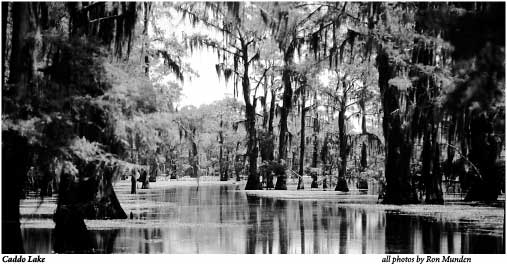
On March 24, 2004, several months prior to the platform adoption, Lewis and Smith spoke at an emergency townhall meeting of the Tarrant County Republican Assembly in Fort Worth on “Seven Flags Over Texas (The UN Is the Seventh Flag).” The announcement for the emergency meeting asks, “Why Is the UN in Texas? Why Do They Want Texas Water? Come Here [sic] about the California-ization of Texas and About the Republicans That Are Helping the Wrong Side.”
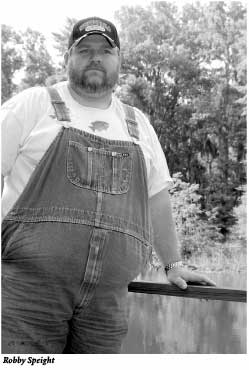 Robby Speight, a burly character sitting at the lunch table at Dawn’s who is president of the Greater Caddo Lake Association, recalls meeting a State Department official at a national lake conference a year ago. The official told him they had a name for people who get their dander up about the United Nations’ support of the Ramsar Convention and are forever paranoid about the world body’s imminent invasion: “the black helicopter crowd.” The State Department official allowed that the case of the retired general and Mayor Smith successfully lobbying to get it written into the Texas Republican Party platform was a little more extreme than usual. Obviously, the State Department official doesn’t know Texas.
Robby Speight, a burly character sitting at the lunch table at Dawn’s who is president of the Greater Caddo Lake Association, recalls meeting a State Department official at a national lake conference a year ago. The official told him they had a name for people who get their dander up about the United Nations’ support of the Ramsar Convention and are forever paranoid about the world body’s imminent invasion: “the black helicopter crowd.” The State Department official allowed that the case of the retired general and Mayor Smith successfully lobbying to get it written into the Texas Republican Party platform was a little more extreme than usual. Obviously, the State Department official doesn’t know Texas.
The lunch crowd at Dawn’s is laughing because, for all the ongoing battles between the lake people and the city of Marshall over water rights to Caddo and the fulminations from the black helicopter crowd, the war on Caddo Lake is over. Battles are still being fought and skirmishes are forever, but when all is said and done, the good ol’ boys and good ol’ girls who live and work on the lake won, and they know it.
Although a last minute state court ruling or political intervention is never out of the question, Caddo Lake as an untapped source for water hustlers is off the table. The water right to 40,000 acre feet that the Army had but never fully utilized when it oversaw an ammunitions plant by the lake, which politicians from the city of Marshall also coveted to sell to an industrial user, is being handed off to the U.S. Fish & Wildlife Service, the overseer of the national wildlife refuge being created on the site of the ammo plant, and the Fish & Wildlife Service’s interest in water marketing is less than zero.
Caddo Lake is unlike any other lake in the state. It’s the only lake with an honest history because it is the only honest lake in Texas, having formed naturally sometime during the 19th century. It’s the only Texas lake with its own body of literature, including Love Is A Wild Assault by Elithe Hamilton Kirkland, the twisted, true-to-life romance novel based on the life of Harriet Moore, aka Harriet the Brave and Beautiful and Kishi Woman of Caddo Lake; Caddo Was … A Short History of Caddo Lake by Fred Dahmer, the definitive Caddo Lake book; Every Sun That Rises, stories told by Wyatt Moore, another lake sage who was a boatman, fisherman, guide, trapper, raftsman, moonshiner, and roughneck as well as a gifted storyteller; and Jacques D. Bagur’s recent A History of Navigation on Cypress Bayou and the Lakes, the extensively researched history of boat traffic that has debunked several myths about the lake.
Fine as books may be, full appreciation of Caddo Lake is a two-step program. First, one must reach back in the mind’s eye, beyond the printed word, beyond the Great Raft jam on the Red River (most often cited for forming the lake out of the Big Cypress Bayou in the early 1800s), beyond the New Madrid earthquake of 1811, also attributed as the source, and even before to the Caddo Indians and their legend of the chief who had a vision and told his people to move to higher ground in advance of a deadly wall of water that covered their village overnight. Going to Caddo is going all the way back to the beginning of time, when the towering bald cypress—Texas’ own redwoods—were common all over the Earth, not just in the few selected nooks and crannies like Caddo Lake where they persist today, bearing witness to the primordial soup that spawned all life.
Next, spray yourself down for mosquitoes, chiggers, and other bugs, walk out on the dock in the back of the cabin you’ve rented, and take it all in. The foreground is defined by a coating of duckweed floating on the water in a surreal electric lime-green swirl. The background is dominated by a wall of bald cypress soaring skyward. In between, herons and cranes pick their way through the muck to stab and grab a small crappie or some other object of desire while a red-shouldered hawk and a green heron play out a quiet drama as the hawk swoops out of high branches of its tree to hassle the heron for infringing on its space by perching on a branch too close. The give-and-take is accompanied by a noisy soundtrack of bullfrogs burping out percussive bass lines to rhythmic ensembles of locusts, cicadas, and crickets buzzing, clicking, and whirring. Part swamp and consisting of a series of lakes of varying size, shape, and depth, Caddo Lake is roughly 23 miles long and covers 40,000 acres in high water, making it the second biggest natural lake in the South and easily one of the most inspiring, which explains the Ramsar recognition.
Caddo is almost as significant for what it is not: no condos, no high rises, no chain motels or restaurants, no resorts, no gated, planned communities, no margarita bars, no chains, no pretension, none of the trappings of modern Texas Lake Culture. Cell phone service here is as spotty as it is in Big Bend. The Big Bend comparison is intentional. Caddo Lake may be in northeast Texas and relatively close to urban centers in all directions, but for those who get Caddo, it is a natural jewel just as worthy of protection.
Still, it should not be confused for pristine. A lot of bad things have happened here. Almost all the virgin timber was gone more than a century ago. Dam building upstream and downstream along Cypress Creek all but eliminated floods, which rob the riparian forest of much of the soup of rich nutrients deposited on the topsoil in high water. The lake is downwind of several electricity-generating plants powered by cheap but dirty-burning lignite coal containing mercury. Texas Tech toxicology scientist Thomas Rainwater discovered the highest concentration of mercury ever found in a snake while studying a cottonmouth rattlesnake from Caddo Lake. Consumers are warned to eat no more than 8 ounces of bass or drum from the lake per month due to high levels of contaminants. The presence in the water supply of pharmaceuticals from the chicken processing industry is becoming a concern. The highest level of acid rain west of the Mississippi River has been recorded here. And the City of Marshall still wants to utilize part of its right to draw 16,000 acre feet of water a year just upstream of Caddo to attract an industrial user.
Many of those problems aren’t going away soon. It will take time, money, and community consensus to fix them.
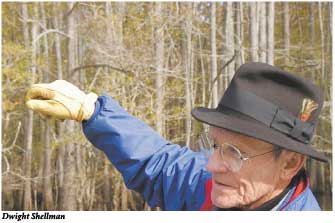 This story was originally going to be about Don Henley, Dwight Shellman, and the Caddo Lake Institute they founded together and how the Texas Republican Party came to hate them. Henley is the East Texas musician who spent some of the millions he’s earned with the Eagles, one of the most popular bands of all time, to save Henry David Thoreau’s Walden Pond. Henley founded the Walden Woods project, which raised $17 million to protect Thoreau’s beloved Walden Pond from development, before turning his sights on his own Walden, Caddo Lake, about 25 miles from Linden, the town where he grew up. In 1993, Henley enlisted Shellman, an attorney and his neighbor in Aspen, Colorado, where he keeps a vacation home, to co-found the Caddo Lake Institute (CLI). Shellman moved part-time to Uncertain, pop. 194, the largest community on the lake and, as president and general counsel for the institute, began showing locals how to use science, education, and the courts to protect the lake and their property.
This story was originally going to be about Don Henley, Dwight Shellman, and the Caddo Lake Institute they founded together and how the Texas Republican Party came to hate them. Henley is the East Texas musician who spent some of the millions he’s earned with the Eagles, one of the most popular bands of all time, to save Henry David Thoreau’s Walden Pond. Henley founded the Walden Woods project, which raised $17 million to protect Thoreau’s beloved Walden Pond from development, before turning his sights on his own Walden, Caddo Lake, about 25 miles from Linden, the town where he grew up. In 1993, Henley enlisted Shellman, an attorney and his neighbor in Aspen, Colorado, where he keeps a vacation home, to co-found the Caddo Lake Institute (CLI). Shellman moved part-time to Uncertain, pop. 194, the largest community on the lake and, as president and general counsel for the institute, began showing locals how to use science, education, and the courts to protect the lake and their property.
This story was also going to be about the vendetta waged by retired General Vernon Lewis, the former head of the Cypress Valley Navigation District, which is responsible for maintaining the lake’s boat roads, against Shellman and the CLI. Lewis’ field of battle has largely been the op-ed page of the weekly newspaper he co-publishes, the Lone Star Eagle. When asked about his dispute with Shellman, General Lewis is blunt. “He’s going to go away someday, and when he goes away, this Caddo Lake Institute is going to go away. This is a one-man show and it is all about money and environmental power. They don’t give a shit about Caddo lake.”
Shellman’s sin was to organize various lake interests and challenge the political status quo. The Caddo Lake Institute’s initial emphasis was on science, research, and school partnerships to define exactly what the lake is. Much of that accumulated data has been put to use. Shellman raised the question of the consequences for the lake if Marshall utilized its full right to 16,000 acre feet of water taken from just upstream of the lake. Caddo Lake interests protested a proposed power plant for American Electric Power that was eventually sited elsewhere. The institute applied for an in-flow water right for the lake and the Cypress Basin. Several lake residents sued power plants in East Texas for emissions causing mercury contamination. When Marshall tried to switch its water right permit from municipal to industrial use, Shellman litigated the city’s ability to do so without a contested hearing all the way to the Texas Supreme Court. (The case was heard in October 2004. At press time, a decision is still pending.)
But Shellman, who is stepping down at the Caddo Lake Institute at the end of the summer, isn’t the story. Neither is the retired general. The longer one lingers on the lake, the clearer it becomes that it’s the people in between who will determine the lake’s future.
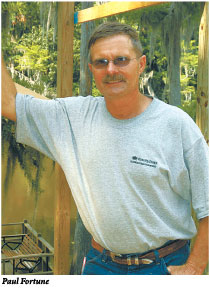 Shellman is an Aspen lawyer. Paul Fortune grew up on Caddo Lake in a one-room shack on Pine Island Road on Big Cypress Bayou that his family moved into in 1953 following a house fire. “We had no running water; we had no indoor plumbing,” he says, but he did learn a lot about fishing and hunting and paddling. “I’m not very educated,” he says. “I graduated high school in a class of 12 and I wasn’t in the top 10. Caddo Lake has been my bread and butter. There’s no other place like it.”
Shellman is an Aspen lawyer. Paul Fortune grew up on Caddo Lake in a one-room shack on Pine Island Road on Big Cypress Bayou that his family moved into in 1953 following a house fire. “We had no running water; we had no indoor plumbing,” he says, but he did learn a lot about fishing and hunting and paddling. “I’m not very educated,” he says. “I graduated high school in a class of 12 and I wasn’t in the top 10. Caddo Lake has been my bread and butter. There’s no other place like it.”
A clean-cut, spine-erect go-getter, he followed his father in getting a job at the Lone Star Ammunition Plant, which opened in 1944 and employed as many as 2,400 workers until it ceased operations in 1995. Fortune left the plant in 1980 but never really left the lake, where he builds houses and serves as vice-president of the 700-member Greater Caddo Lake Association. Lately, he’s been hanging around the administration building of the ammo plant again, this time to help transform the property from a $44-million Superfund cleanup site to the Caddo Lake National Wildlife Refuge, an 8,500-acre symbol of the lake’s future.
“The first time I met Dwight Shellman was six years ago with a group of local people,” Fortune remembers as he shows me around the old administration building, where the refuge will be headquartered and the Caddo Lake Institute will lease offices. “We were told this might be a wildlife refuge if the community wanted it. Don Henley had the connections, but Dwight said Don didn’t want to waste his time and money if the local people don’t want it.” Fortune and nine others were flown to Bosque del Apache National Wildlife Refuge south of Albuquerque, courtesy of Henley, and were sold on the idea.
“We had heard of other uses—a prison, a chicken processing plant, industrial park,” he says. “All of that sounded good for the local economy, but they weren’t compatible with Caddo Lake right here.” Fortune credits Shellman for being “so durn persistent” in making the refuge a reality and recognizes that Shellman’s work is almost done.
“For years, Dwight’s been retiring. He’s like my father—he can’t quit. But I think Dwight realizes somebody needs to take the helm, if there is somebody. He wants to find that person to do it. To my knowledge, he hasn’t found that person yet.”
Shellman could do worse than Fortune. He’s one of several lake people I encountered who are passionate about the lake and projects like the refuge, where planning for public access is underway, including wildlife observation areas for hikers, bikers, and equestrians. There’s hope the refuge’s infrastructure will siphon off some of the $1.2 billion birding and wildlife observation brings into the Texas economy annually, most of it currently being spent along the coast and in the Rio Grande Valley.
Fortune gets almost gaga talking about Harrison Bayou Bottoms, 1,400 acres tucked back in the wildlife refuge that is a rare slice of old-growth hardwood river bottom. The acreage was initially leased from the Army by the Caddo Lake Institute before it was integrated into the national wildlife refuge. “I would like to see a boardwalk into a portion of where it is totally undisturbed, but where people can view this,” Fortune says. “Man has altered Caddo Lake something fierce. Places like Harrison Bayou Bottom prove it’s still a salvageable lake.”
The refuge purchase complements more than 8,000 acres on the north side of the lake, designated a state wildlife management area in 1992 through land buys by the Texas Nature Conservancy, and the 800-acre Caddo Lake State Park on the other side of the town of Karnack, effectively blocking major development along Caddo’s shoreline.
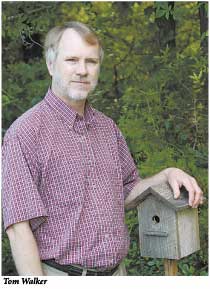 Tom Walker, the mild-mannered, fifth-generation local, part-time librarian, pro-life Christian, and vacation Bible school teacher who introduced me to Paul Fortune, is the e-mail version of Paul Revere on Caddo Lake, the communicator who keeps a long mailing list apprised of affairs that affect the lake. He’s also a birder, so when I find a wren chick on the front stoop of the cabin where I’m staying, I know to take it to Walker, who conducts bird-banding sessions on his family homestead. A day later, he’s sending photo updates via e-mail.
Tom Walker, the mild-mannered, fifth-generation local, part-time librarian, pro-life Christian, and vacation Bible school teacher who introduced me to Paul Fortune, is the e-mail version of Paul Revere on Caddo Lake, the communicator who keeps a long mailing list apprised of affairs that affect the lake. He’s also a birder, so when I find a wren chick on the front stoop of the cabin where I’m staying, I know to take it to Walker, who conducts bird-banding sessions on his family homestead. A day later, he’s sending photo updates via e-mail.
Walker lives at the family homestead near the lake, where I nibble fat blueberries out of his garden and listen to him bang out three ragtime-influenced compositions about alligators, herons, raccoons, and Caddo Lake on a dusty upright piano before going for a drive along the north shore of Caddo. We’re looking for Buddy Man Andrews, the 85-year-old African-American wise man of the lake, but Buddy Man isn’t home, so we meander over to Goat Island while Walker calls out birds by sound and sight—downy woodpecker, Acadian flycatcher, northern cardinal, summer tanager, juvenile little blue heron, blue jays, red-tailed hawk, red-shouldered hawk, Cooper’s hawk, red-eyed vireo, white-eyed vireo, tufted titmouse, Carolina wren, blue-gray gnat-catcher, pine warbler, eastern phoebe, mockingbird, mourning dove, little egret.
During the drive, his family history rolls out. William P. Watson settled the homestead in the 1850s when he arrived from North Carolina and married Walker’s great-great grandmother. Watson’s father-in-law, Ward Taylor, founded the daily Jefferson Jimplecute in 1848. Watson’s daughter, Molly, married Andrew Jackson Carter, for whom Carter’s Lake, part of Caddo Lake, is named. The county road leading to his house is named after his father, Boots Walker.
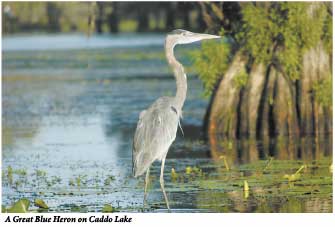 We also talk about Christians and the environment. Walker is flustered that evangelicals flail against concepts such as minimal flows and conservation easements. “Those people think man’s dominion over the world means exploiting it,” he says. “Adam and Eve were in the Garden of Eden to take care of it. Noah had a responsibility to care for the animals.”
We also talk about Christians and the environment. Walker is flustered that evangelicals flail against concepts such as minimal flows and conservation easements. “Those people think man’s dominion over the world means exploiting it,” he says. “Adam and Eve were in the Garden of Eden to take care of it. Noah had a responsibility to care for the animals.”
We drive to Jefferson, pop. 2,912, 14 miles west of the lake and the most perfectly restored small town in Texas I’ve ever visited. Once the major steamboat port-of-entry where thousands of new arrivals first set foot on Texas soil, the one-time boomtown spent most of the 20th century as a ghost town thanks to the advent of railroads and highways, but it was rediscovered in time to save most of the historic structures and reinvent the eight-block downtown by the waterfront into a pedestrian-friendly tourism magnet that is packed most weekends with visitors from Dallas, Houston, and beyond.
Walker introduces Dr. Carroll Harrell, the program director of the Jeffersonian Institute, the town’s equivalent of the Caddo Lake Institute, who breathlessly informs us Richard Subia, the great-great-great grandson of the last Caddo chief, is coming to the institute the next day to speak. Harrell’s doctoral dissertation focused on the populations living in Marion County, including the Caddo, who she says maintained a strong presence around the lake even after Chief Tarshar signed a treaty with the white man in 1835 and most of the tribe moved to the Brazos River and later to a reservation in Oklahoma. “They were in a swamp, so nobody knew they were there anyway,” she explains. “When [white] settlers moved in, there was a blending together.” The Caddo word tejas, from which Texas was derived, means “friend.” The Caddo word for African-Americans translates as “kin.”
Dr. Harrell knows a few things about the region’s history. “Jay Gould is a myth,” she says dismissively of the robber baron who is said to have placed a curse on Jefferson when the town would not accommodate his railroad. And while it’s true that Howard Hughes’ father developed the world’s first offshore oil rig on the lake in 1917, the lake’s permanent weir dam in Mooringsport, Louisiana, wasn’t constructed for that purpose; it had already been in place for several years. And, no, Harrell insists, the Jeffersonian Institute is not just about preservation. “Our challenge at the institute is how do we create a sustainable economy utilizing the history, the culture, and the environment with education as the driver?”
The Jeffersonian Institute’s driver is Jesse M. (Duke) DeWare, who wears many hats around town—City of Jefferson Attorney; Cypress Valley Alliance President; Jeffersonian Institute President; and director of the Marion County Industrial Foundation. After attending the Citadel and law school, he came home and broke into the cabal who ran Jefferson. DeWare purchased the last forest fire lookout tower in Marion County from the Texas Forest Service and reassembled it in downtown Jefferson as a historical artifact while adding a cell phone tower and a WiFi tower on top. He’s been involved with the Army Corps of Engineers in an environmental restoration of the waterfront that will include an amphitheater, walking trails and boardwalks, and an outdoor education component to educate students about wetlands. He’s also promoting nature tourism as a means to link together Jefferson and Caddo Lake in order to bring visitors to the region, rather than to a specific town.
“Here, we believe in economic development,” he says with the certainty of one who’s figured it out. “A big key to that is preserving your environment. It goes hand in hand. There is no conflict. You preserve your environment; you will have sustainable economic development. We want to embrace it in every way we can. We want to attract people here to protect it. People we’ve grown up with don’t realize those assets; it’s no big deal. The people moving in are choosing it.”
In other words, Jefferson gets it, just like Austin gets it, Terlingua and Marathon get it, and Port Aransas gets it. Towns and cities in close proximity to parks and open space can make money off their location, as has happened to places like Moab, Utah; Bishop, California; and Port Angeles, Washington.
“My biggest challenge is to reinvent the community to keep up with everywhere else,” DeWare says. “We want to be the most well-preserved city in Texas, but we also want to be a 21st-century pedestrian community with global technology. There are people who can live anywhere in the world as long as they can communicate. If they can’t communicate like they want to, you’re not going to get those people.”
As lush as the lake appears to be to a visitor’s eye, locals point out that, like most of Texas, it is in the throes of drought. “It’s almost down to the top of the spillway,” Robby Speight says during a slow cruise around the lake. “If Marshall was pulling its full water right, you’d feel a reverse current,” he says. He points out another threat to the lake’s health. “See that purple flower? That’s a hyacinth. It sucks the oxygen out of the water, and fish don’t live underneath it.” The Greater Caddo Lake Association is starting their own hyacinth suppression program to augment state efforts. After Speight attended the Flows Conference in Karnack organized by the Caddo Lake Institute in May, he came away supporting a study of controlled flooding of the lake to mimic nature. “They’re not seeing any new growth of cypress,” he says, “so scientists are looking at manipulating the flow.
“For a long time, I took this for granted,” Speight smiles as he surveys the water around him. “Now, I don’t.”
At their next state convention, Texas Republicans might consider calling for the eradication of the ivory-billed woodpecker. The most sought-after bird in North America, thought to be extinct, was last spotted around Caddo Lake in the 1930s. This spring, the first sighting of an ivory-billed in 60 years was confirmed in the Big Woods of southeastern Arkansas, a similarly wooded swampland about 200 miles from Caddo Lake—close enough, as the bird flies, to make plausible an ivory-billed woodpecker sighting around Caddo Lake. If that happens, they’ll have to build walls around the lake to keep birders out.
Dwight Shellman finally weighed in via e-mail after I’d returned from Caddo. He confirmed he’s leaving as the institute’s chief administrator in September although he says he may take on special projects “until the institutional transaction is accomplished to my and Don’s satisfaction.”
The lake people are now armed with the knowledge needed for community stewardship of the lake and its watershed, and to address issues such as mercury contamination, minimal flows, how to work with the Texas Council on Environmental Quality, water districts, and academics, and how to train local people to protect their lake and wetlands.
The National Wildlife Refuge designation is clearly a point of pride. Shellman wrote, “CLI worked for years with the decontamination effort to learn its dimensions, and then used that information to create very difficult technical GIS (Geographic Information Systems) mapping—to identify the 7,200 (7/8ths) uncontaminated acres that were ready for immediate refuge purposes and the 1,000 other acres to be taken into the Refuge—when cleaned of contaminants. We then facilitated the transition of that transfer with several federal and state agencies and the community and built them into a team rather than competitors.
“None of this would be possible without Don’s unswerving loyalty to this place and willingness to raise money when the chips are down. He makes locals confident that they will be able to defend; it may also help careless or potential spoilers to be more careful about listening, learning and trying to join our conservation efforts rather than fighting them. There is usually scientific common ground to meet on, with everyone who is prepared and flexible.”
This puts Shellman in an uncomfortable position. “I love the place and the people I have come to know so well in 14 years of work and living there,” he wrote. “I am torn as to whether I need to get out of the way and be absent so successors can make the program their own, or continue to live there. Living there requires me to learn to keep my opinions to myself—a trait I am not celebrated for. So, it’s not clear I will leave—or just put some burdens down or pass them on to new creative people and stay.”
Whatever he does, the lake will still be here, and so will the lake people who have learned to love and fight for Caddo Lake as passionately as Henry David Thoreau felt about his beloved Walden Pond.


